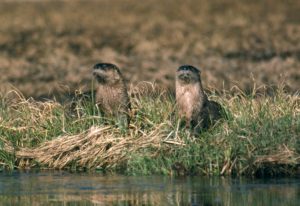We have much more to do and your continued support is needed now more than ever.
Administration Seeks to Gut Landmark Environmental Protection, Limit Public Comments
The Trump Administration’s Council on Environmental Quality has officially announced it will go after the National Environmental Policy Act (NEPA). While most Americans couldn’t tell you what this act is, every single one of us enjoys its benefits, as well as the tools it provides to weigh in on proposed projects in our own communities.
Let’s walk through what the National Environmental Policy Act is, why it’s so important, and why the National Wildlife Federation is rallying to protect it.
What is the National Environmental Policy Act?
The National Environmental Policy Act is one of the most important laws ever passed for protecting wildlife habitat, public health, and public input into projects in their communities. It guides decisions on the construction of highways, the permitting of pipelines, construction of federal water projects, the management of public lands and waters, and the consideration of climate change. We teach our children to “look before you leap” – this act sensibly requires our government to do the same.
Simply put: NEPA safeguards your voice and the voices of communities and everyday Americans who want a say in the decisions that affect their water, land, and air — as well as wildlife. Without this law, policymakers would lose the information and perspectives they need to make the best-informed decisions.

The legislation was part of a wave of landmark environmental changes passed in the wake of the air, water and public health crises that drew national attention during the 1960s. The desire for protection and public input embodied by NEPA were fueled in particular by federal highway projects cutting up American communities and wildlife habitat, as well as the 1969 Santa Barbara oil spill that devastated seabirds, dolphins, elephant seals and sea lions. The National Environment Policy Act passed into law with an overwhelming bipartisan majority in Congress and was signed by President Nixon on January 1, 1970.
At the heart of this review process is the common sense directive to look before you leap with the support of information provided by members of the public and experts. It gives you the right to participate in government decisions that affect the environment and your health and safety.
What Does NEPA Protect?
NEPA success stories are as numerous as they are varied – from the construction of the Hoover Dam Bypass to the redevelopment of the country’s largest brownfield site in Atlanta to the continued preservation of Giant Sequoia National Monument, to the protection of 50,000 acres of wetlands that constitute the last connection between the Mississippi River and its natural floodplain in the state of Missouri. Thanks to this law, hundreds of millions of Americans have participated in important federal decisions.
Public input is important to ensure all relevant information is considered, resulting in better projects. A thorough vetting of alternatives and accounting for varying stakeholder views leads to money better spent, conflicts avoided, and a more strategic approach toward major federal investments and decisions.
“Public involvement and careful consideration of alternatives has produced better outcomes – for the agencies themselves, for the nation, and for the human environment,” said the late Russell Train, former Republican CEQ Chair, Environmental Protection Agency head and NWF’s 1975 Conservationist of the Year
Some other notable successes:
- Mississippi River Delta Restoration: As we confront an unprecedented restoration opportunity in the Gulf of Mexico following the BP oil spill settlement, NEPA is a critical tool in ensuring that all stakeholders, from industry to local communities, have a say in how the work of restoration unfolds in a manner that protects communities, a massive array of migratory seabirds, fish and wildlife, and their habitat.
- Colorado’s Canyon of the Ancients National Monument: Citizens groups in southwestern Colorado were able to use the National Environmental Policy Act to work with the Bureau of Land Management to design an oil & gas exploration project that enabled lessees to obtain the seismic information they needed while avoiding the land’s most significant cultural features and fragile habitats that support mule deer, bobcats, and dozens of species of birds.
- Protecting the Pearl River: The One River, No Lake Coalition opposes the U.S. Army Corps of Engineers’ attempt to dredge, widen and dam the Pearl River in Jackson, MS. The National Environmental Policy Act has ensured thoughtful public input that so far has kept the project on the shelf. The Pearl River is home to more than a hundred species, including the threatened Gulf sturgeon and ringed sawback turtle.
- New Hampshire & Maine’s Umbagog National Wildlife Refuge: Moose, white-tailed deer, river otters, and beavers are among the many wildlife that call Umbagog home, and a truly incredible 229 bird species have been seen there. With more people living near the refuge leading to more desire for public access, the U.S. Fish & Wildlife Service used the National Environmental Policy Act to engage local communities on how they wanted to enjoy their public lands. The refuge’s new master plan balances conservation and public use – including dog-sledding, horseback riding, expanded turkey hunting, bicycling, and increased boat access – while also identifying areas for expansion.
Natural Resources Defense Council has a list of NEPA success stories in every U.S. state and territory.
What Cuts Are Possible?
We’re still learning details of the Trump administration’s plans, but here are some likely avenues of attack:
- Restrictions on public input: The administration is considering limiting the public’s ability to participate in decisions in their communities by limiting the scope of NEPA reviews, the types of harms considered, and the amount of time the public has to provide comments.
- Limiting consideration of reasonable alternatives: The administration is considering rolling back the requirement for agencies to look for reasonable alternatives to a project that may cost less, have fewer impacts on wildlife and the environment, or show that the project may be unnecessary and unwise.
- Prioritizing Speed Over Accuracy: What the administration is considering could impose extremely short and strict hard deadlines for project approval, regardless of project size, complexity, and potential harm to wildlife or the degree of public controversy over a proposal.
Why Attack NEPA?
If the National Environmental Policy Act is such a useful tool for ensuring public engagement and smart federal decision-making, why would anyone want to change it? Because ultimately, this act empowers local communities to protect themselves and their environment from dangerous, rushed, or poorly planned federal projects. As the saying goes, time is money, and proponents don’t want to see their projects delayed or killed, no matter the reason.

The National Environmental Policy Act guards against shortcuts that may save project proponents money by exploiting public resources for private gain. For example, digging up nearby wetlands to use the soil sure can save truckloads of money on construction materials! But that costs us all in lost fish and wildlife habitat and degraded stormwater management.
There’s also a political component here. NEPA opponents are testing the waters right now, seeing how far they can go to cut environmental and public voice protections without a massive backlash.
That’s why it’s so critical that we speak up – now and loud – to oppose any cuts to NEPA protections.
What Can We Do?
The National Wildlife Federation, from our DC-based National Advocacy Center to our regional centers to our state and territorial affiliates, is working to defend strong NEPA protections.
“The National Environmental Policy Act has led to better, smarter projects nationwide and has saved taxpayers money time and time again. Our rivers are healthier, our air is cleaner and our communities are safer thanks to this historic piece of legislation,” says Jim Murphy, the National Wildlife Federation’s senior counsel. “Citizen input has changed a great many projects for the better and has stopped a handful of unwise projects from ever being built. Without NEPA at its full strength, our nation’s quality of life and wildlife heritage will suffer.”

We’ll be working to educate our elected officials and policymakers in DC, and to tell the story in towns, cities and states across the country of how this act benefits our communities and wildlife by protecting our natural resources and our ability to weigh in on decisions that affect our lives.
You can donate now to support the National Wildlife Federation’s work, and contact your members of Congress directly and ask them to protect the National Environmental Policy Act.






















